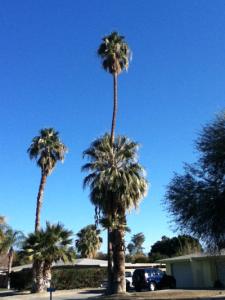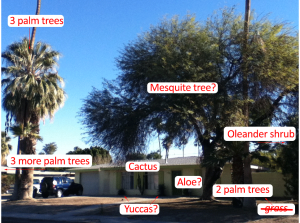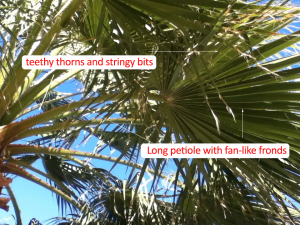To contrast with the endless rains of recent weeks Dr M is pleased to present this guest blog: an eXtreme botanical story from drier climes!
 Once upon a time, in a land far, far away, there was a desert, and in that desert was a house, and beside that house was a garden and in that garden was a visitor, a botanist and plant lover, all the way from England.
Once upon a time, in a land far, far away, there was a desert, and in that desert was a house, and beside that house was a garden and in that garden was a visitor, a botanist and plant lover, all the way from England.
For this visitor, the desert was a rather new and wonderful place, full of curious and unknown plants. Being a botanist, that visitor wished very much to identify the plants around her. But being far, far away, this place had no plant ID books and no internet access. So what was she to do?
Well that botanist was the Plant Curator, and here is her story, her desert diary, a diary of a couple of days in which she set about identifying the desert plants in the garden equipped only with the tenacity and the motivation that is borne of eXtreme botany…
“It’s easy to ID plants when you know them like he does. Quite hard when you don’t, even harder when you don’t have a good ID book (i.e. one with no key) and nigh on impossible without the Internet. No Internet! I might as well be on the Moon!”
“But in the spirit of eXtreme botany I must give it a go while residing at my temporary abode at Whispering Palms Trail (a clue there perhaps) in Cathedral City, just west of Joshua Tree National Park in the Coachella Valley, California.”
“The task I have set myself is to identify all the plants growing in the front garden over the next few days. It is quite, vegetatively speaking, sparse, so I am not too overwhelmed, although I think I may ignore the grass popping up by the leaking drain. Didn’t see it, it’s gone, poof…!”
Day 1 – Initial reconnaissance
 “There is an Oleander (Nerium oleander) shrub not in flower. I know this because there is a flowering one in the back garden and seemingly everywhere else in this town. I notice that it has lovely elongated ribbed buds that are nice to hold but think this plant is pretty toxic so I don’t hold them for long. There is a rather large cactus that I would call an Organ Pipe at the moment, but with no evidence except that’s the name that springs to mind.”
“There is an Oleander (Nerium oleander) shrub not in flower. I know this because there is a flowering one in the back garden and seemingly everywhere else in this town. I notice that it has lovely elongated ribbed buds that are nice to hold but think this plant is pretty toxic so I don’t hold them for long. There is a rather large cactus that I would call an Organ Pipe at the moment, but with no evidence except that’s the name that springs to mind.”
“And eight, yes eight palm trees, two really tall thin ones, two quite tall fatter ones and four fat shorter ones. One is fruiting and dropping thousands of little black balls all over the driveway.”
“There are a couple of Yucca-ry type things with the ends snipped off (Why? Who would do such a thing? Don’t care right now, got enough on my plate without investigating that too), an Aloe I believe, (reassuringly, I snap off a leaf and fluid comes out!), and another different looking tree which I am calling a Mesquite although not sure how I came to that conclusion either.”
“In the world of plant ID, I have learnt, that you can’t assume anything so I write all these thoughts in pencil tentatively in my notebook.”
“OK, scoping study done. Tomorrow a more definitive ID with scientific names, common ones will not suffice! There’s a lemon tree in the back I’m 99.9% sure and I’m off to put one of its fruits in my G&T.”
Day 2 – Palm trees
“I definitely know a palm tree when I see one, or eight. I wonder what made the thin one shoot up to the Gods so fast? To get above the thick one which was shading it perhaps? But it’s gone so much farther. It’s gone crazy. Or are they different species? Are they multi-stemmed or just snuggled up? Why is some bark smooth and some latticed? Have they been pruned or is this natural?”
“Now, I know in these parts they have one native palm not found anywhere else, the Californian Fan Palm or Washingtonia filifera, which is noted for its ability to hold on to its fronds, forming a rather lovely skirt. I know this because I visited the local 1000 Palms Nature Reserve and I read all the educational signage.”
“Date palms (Pheonix dactylifera) are also here en masse because they were introduced from Algeria in the 1890s (so my Californian guide book tells me), and many thousands of them now line up in the Coachella Valley producing dates.”
“A mature date palm can produce up to 135 kg of dates a year, which is not far off the quantity of stuff dropped on the driveway. Are they dates? Well if they are, they are dates for very small mouths. They are like tiny sticky balls with a hard brown seed in the middle. I know because I just ate one – a skill all eXtreme botanists should have – oral evaluation.”
“I’m not overly confident though, as last year I touched a plant in the desert and ended up with a rash all over for days, well I think it was a plant, either that or the hot-tub.”
“But I’m in a garden in the desert, so this won’t kill me, it’s a palm tree for God’s sake, no one ever said don’t eat a palm tree, and I am an extreme botany devotee… roar!”
“It tastes sweet, so maybe it is a Date Palm, with small fruits due to lack of cultivation. Can cultivation change a fruit from ~6 mm to over 30 mm? But the fronds are all wrong. So maybe it is one of the other ~90 palm tree species introduced to California, or maybe it’s a cultivar, or a hybrid…arghhh!”
“OK focus. Fronds are like fans – with a long toothed petiole and then a fan shaped end and there are kind of skirts on some of them but on others not so much. I do know that Fortunato, the gardener, does trim them on a regular basis. But what about the tall ones? Surely Fortunato can’t get up that high, he’s in his 70s.”
“Note to self: next time in town, check the internet for how many possible species of palm are found growing in this area. It’s definitely Aracaceae. Family ID is very important.”
 “OK need help. Walk to the library. On the way pass man with a van and a ladder up against a palm tree. ‘Are you a gardener’ I ask recognising a possible leg-up, ‘I can be whatever you want me to be’ he answers. ‘I want to know what kind of palm tree that is’ I say, ignoring the lewdness of the comment. ‘I’m just installing the cable’ he says. ‘Oh, OK, doesn’t matter’ I say slightly disappointed. ‘Where are you from?’ he says, ‘England’ I say. ‘I love Iron Maiden’ he says, at which point I know I’m on a losing streak.”
“OK need help. Walk to the library. On the way pass man with a van and a ladder up against a palm tree. ‘Are you a gardener’ I ask recognising a possible leg-up, ‘I can be whatever you want me to be’ he answers. ‘I want to know what kind of palm tree that is’ I say, ignoring the lewdness of the comment. ‘I’m just installing the cable’ he says. ‘Oh, OK, doesn’t matter’ I say slightly disappointed. ‘Where are you from?’ he says, ‘England’ I say. ‘I love Iron Maiden’ he says, at which point I know I’m on a losing streak.”
“Cathedral City library is beautiful. I log into the Wifi (a stress-relieving word if ever I’ve heard one) and learn the following:
“There are two species of Fan Palm Washingtonia filifera and Washingtonia robusta both native to this area and both used widely in landscaping. Fruits of these Fan Palms are a drupe, with thin layer of flesh over single seed <1 cm, which matches mine. Washingtonia robusta grows very tall with a skinny trunk, whereas W. filifera is shorter and wider. The genus is named after George Washington. Palms are restricted to solitary growth, but can grow in clusters, hence my two clumps of 3. The trunks are grey, ringed with old leaf scars. Petioles (leaf stems) of mature Palms are armed along the margins with curved thorns, something that I noted on the shorter ones. The individual leaflets are pendulous and swing freely in the wind, as all mine do. Abundant cotton-like threads (also noticeable) on and between the leaflets persist even when the California Palm tree is mature.”
“I decide they are all Washingtonia Palms. A possible mixture of both species, maybe some hybrids, with the slight possibility of a pygmy cultivar scenario going on.”
“Next time – the other plants!” [Including the grass I hope?! Ed]
